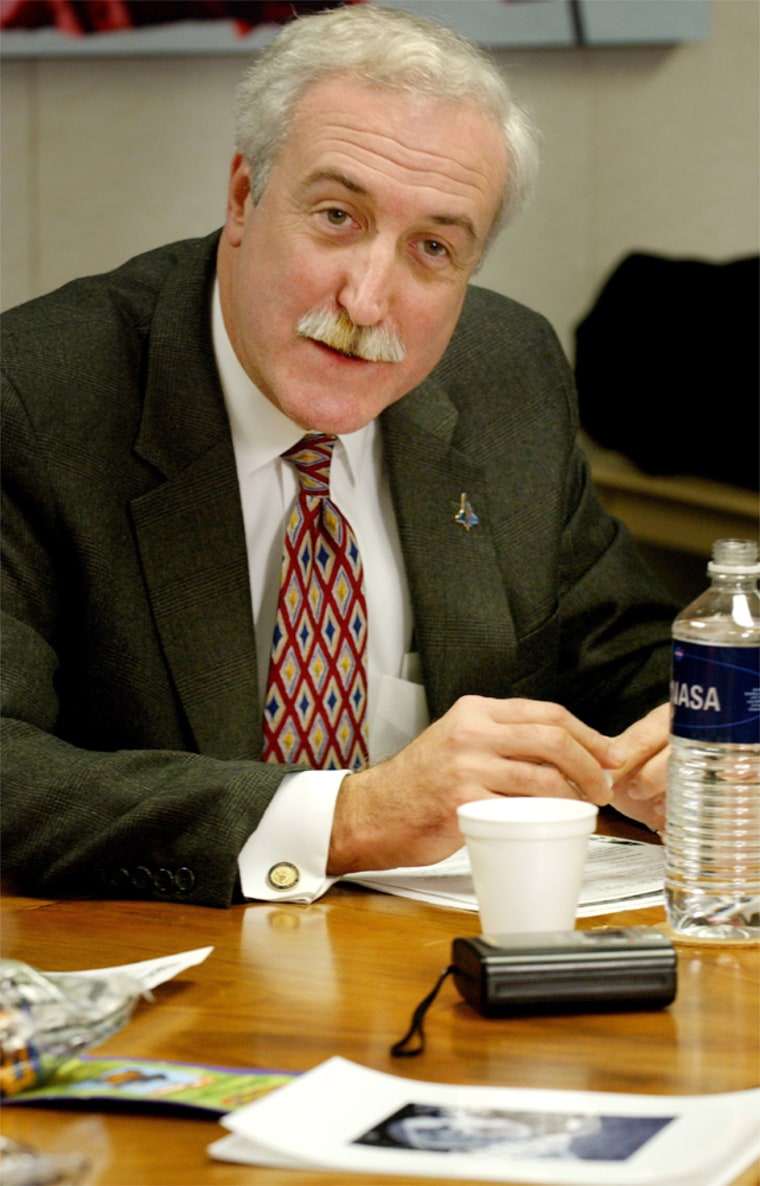NASA Administrator Sean O'Keefe came to the Pacific Northwest on Sunday to talk about the weather — on Earth and on Mars — but ended up dropping hints about a space initiative that would send Americans back to the moon and on to the Red Planet.
President Bush is due to announce the initiative on Wednesday in Washington, and thus O'Keefe was coy about the details during his keynote address at the American Meteorological Society's annual meeting in Seattle.
When a questioner from NASA's Goddard Space Flight Center asked how the White House plan would affect the space agency's role in Earth science, O'Keefe responded with a smile and a stock phrase: "The president will announce what he will announce on Wednesday, and I, for one, am going to be excited to hear what he has to say."
O'Keefe then went on to say that the initiative was "not prepared in a vacuum." He noted that Bush received input during the months-long planning process from the Commerce Department, which cooperates with NASA in climate and weather studies through the National Oceanic and Atmospheric Administration. "What he announces on Wednesday will answer your questions," he said.
$1 trillion? 'Dead wrong'
O'Keefe also offered assurances that the new initiative won't break the bank. Estimates that the moon-and-Mars program would cost $1 trillion were "dead wrong," he told MSNBC.com after his speech.
"This is a policy that will be matched exactly by the resources necessary to carry it out," he said. "This was an issue that we really wrestled with all the way through. Part of the reason it took so long was saying, 'Hey, how do you do something realistic that's ambitious enough, but at the same time you can work with it and get the resources in place to do it?'"
O'Keefe, who was Bush's deputy budget director before he became NASA administrator two years ago, said he felt "very comfortable and confident" about the recommended funding levels. Several media reports have cited a figure of $800 million in extra spending for fiscal year 2005, but O'Keefe would say only that the federal budget proposal to be released Feb. 2 would match the president's space objectives.
Although O'Keefe said $1 trillion was too high an estimate, he declined to be more specific about the long-term cost.
"There's a whole bunch of different avenues that could be taken that could change that, so what you'll get potentially, I'm sure, in the weeks and months that follow, are folks speculating on the range, what it could be, high end to low end," O'Keefe told MSNBC.com. "But in terms of what is dedicated to the resources in the president's budget ... [it's] an exact match with what his expectations are."
From Earth to Mars
In his speech, O'Keefe focused on NASA's role in Earth observation as it applied to climate research and weather prediction. He noted that NASA operated 18 Earth-observing research satellites, and was planning future missions to observe precipitation, as well as the composition of clouds using microwave sensors.
"NASA is definitely in the business of enabling better weather prediction," he said.
He also said the space agency also was playing a key role in studying the dynamics of climate change, including the greenhouse effect as well as other factors. O'Keefe cited the work currently being done by the Terra and Aqua satellites as well as future research to be carried out by Glory and the Orbiting Carbon Observatory. The result, he said, would be climate policy that was "environmentally, scientifically, economically sound and enforceable."
O'Keefe touched on other space topics as well:
- Mars: He showed off the weekend's pictures from the Spirit rover on Mars, and noted that the difference between mission success and failure came down to a "matter of seconds." The Martian atmosphere turned out to be denser than expected, and the temperature was warmer. If the sequence of events during Spirit's descent had been just a few seconds later, Spirit might have hit the surface of Mars too hard, he said. The trajectory and timing for the descent of the Opportunity rover, Spirit's twin, on Jan. 24 would be adjusted "based on what we learned from Spirit," O'Keefe said.
- Columbia's legacy: With the Feb. 1 anniversary of the Columbia tragedy approaching, O'Keefe noted that the shuttle's science mission yielded valuable data on dust storms, solar irradiance and Earth's ozone layer. He also said the shuttle crew's low- combustion experiments could someday open the way to more efficent engines. "The notion that somehow there's something ... just kind of concocted [about the mission] that they were engaged in, I find to be really, really bothersome," he said.
- International space station: O'Keefe said the station was valuable not only because of the science being conducted in orbit, but also because "we're learning an awful lot about that assembly sequence that will have application anywhere else you want to go." In another oblique reference to the White House space initiative, O'Keefe said the construction experience has built up a "knowledge base and capacity that would roll over to any other infrastructure we may want to pursue, based on whatever policy direction for exploration may emerge."
